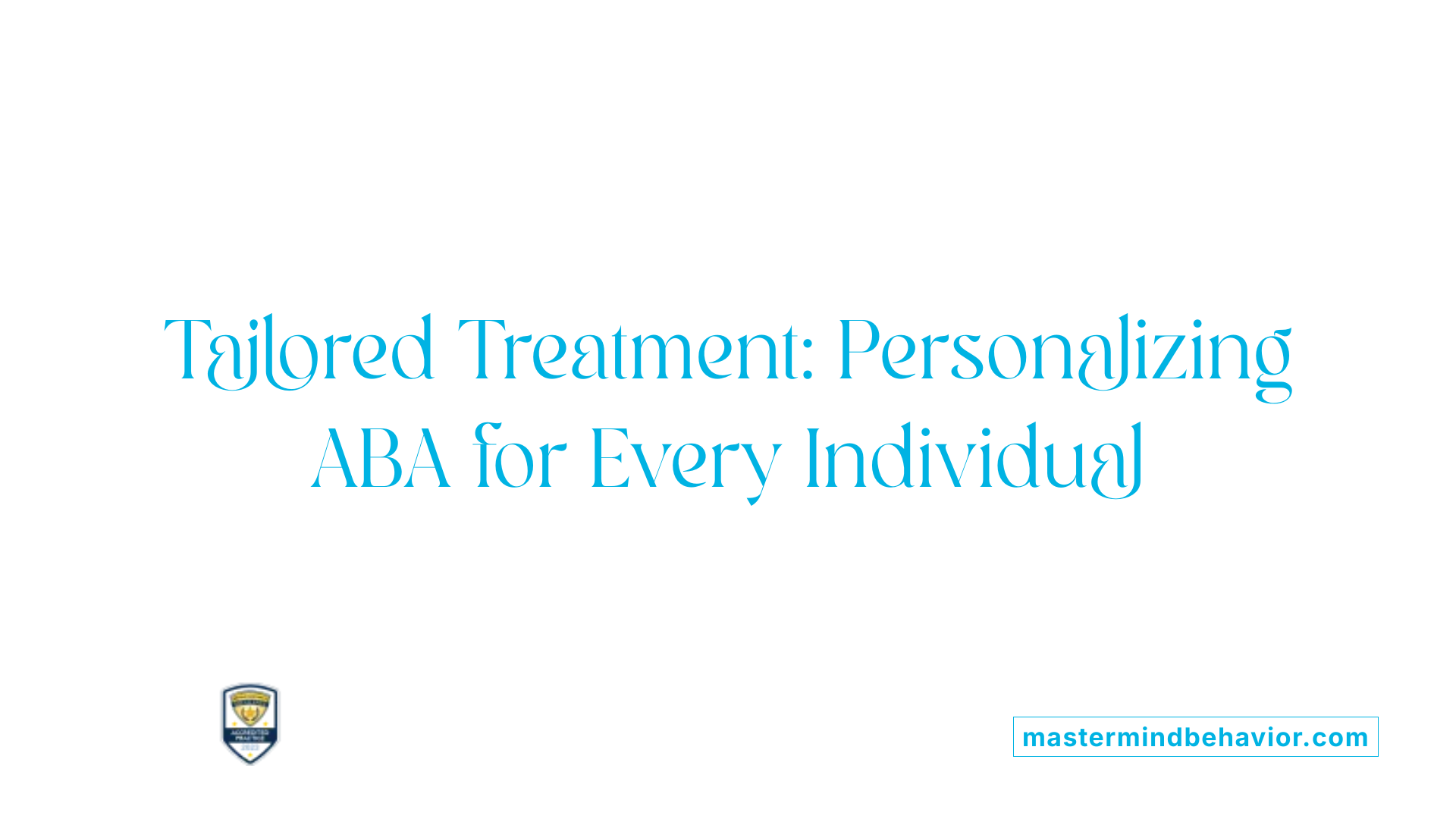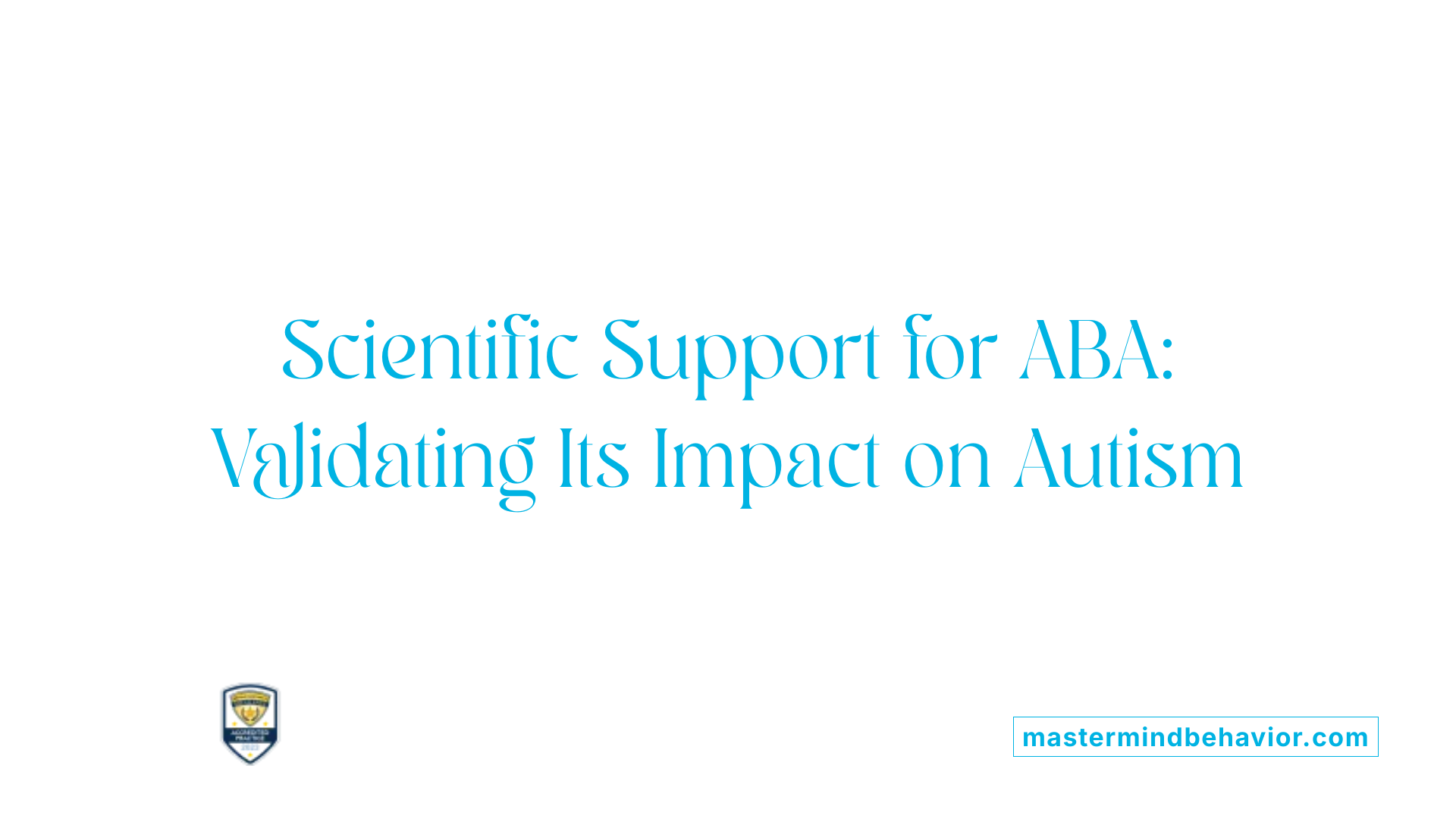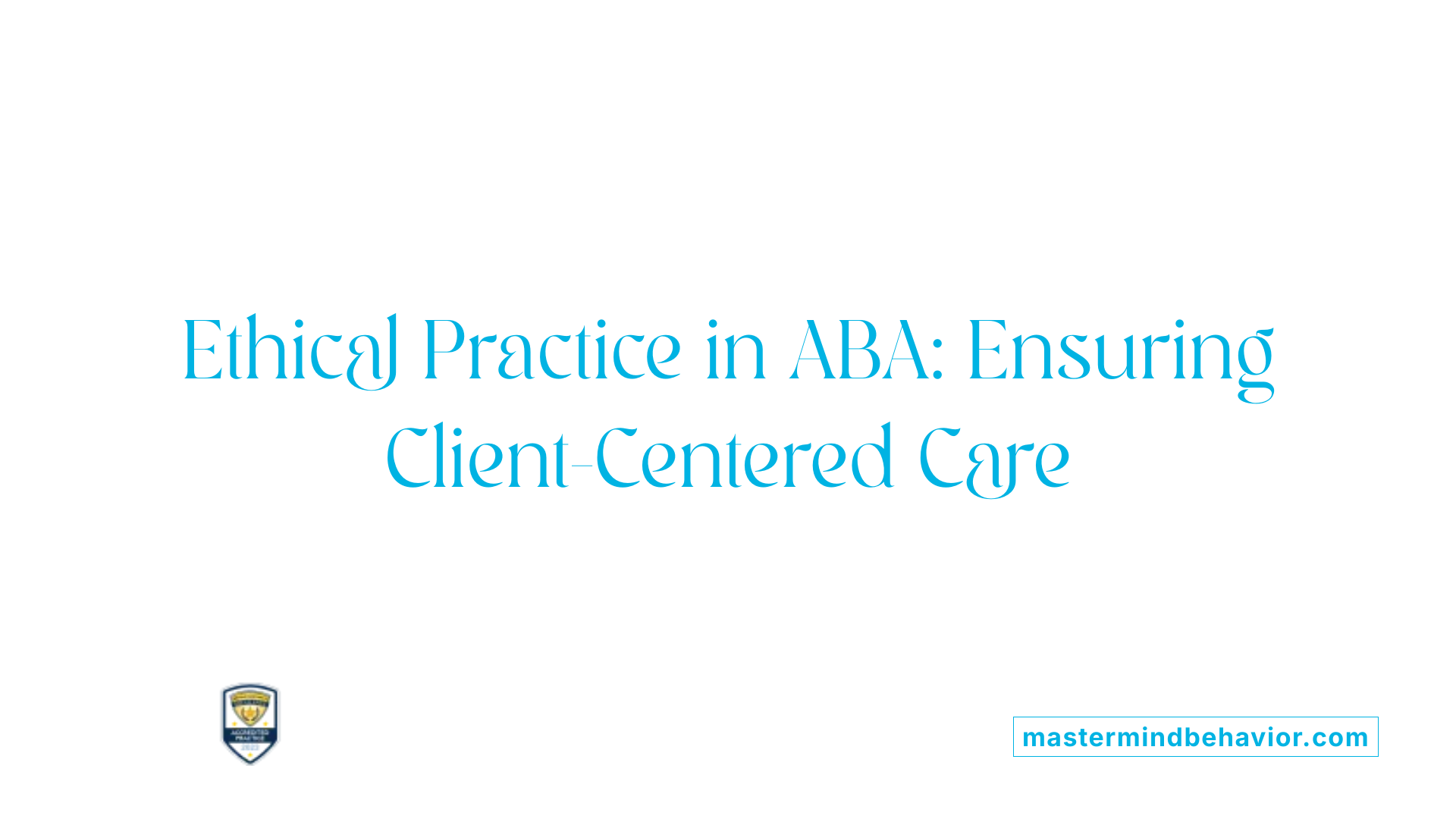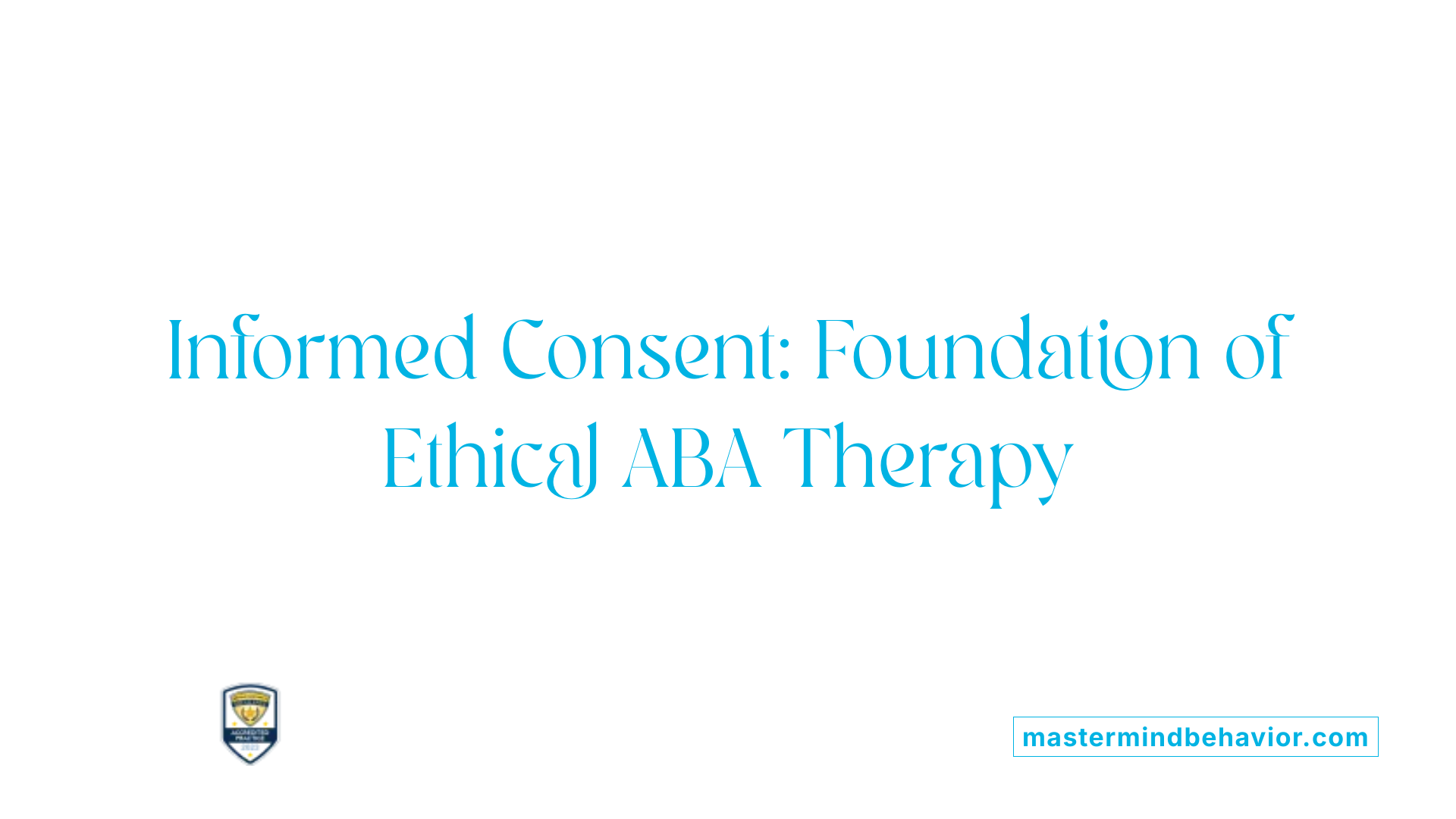What Families Should Know About ABA Therapy Ethics And Consent

Introduction to ABA Therapy and Its Importance for Families
Applied Behavior Analysis (ABA) therapy is a scientifically backed approach that has become a cornerstone in supporting individuals with autism spectrum disorder (ASD) and other developmental disabilities. Families considering ABA therapy often face questions about how it works, who provides it, and what ethical standards and consent processes are involved. This article aims to clarify these essential aspects to empower families in making informed decisions about ABA services.
What is ABA Therapy and How Does It Help Individuals with Autism?

What is ABA therapy and how does it support individuals with autism?
Applied Behavior Analysis (ABA) therapy is a scientifically supported treatment approach designed to help individuals with autism spectrum disorder (ASD) and other developmental disabilities. ABA is grounded in the science of learning and behavior, focusing on understanding how behavior works, how the environment affects it, and how learning occurs.
How does ABA therapy work?
ABA therapy employs the ABC model—Antecedent, Behavior, Consequence—to assess and modify behaviors. Practitioners identify what happens before a behavior (antecedent), observe the behavior itself, and analyze the consequence that follows. This process helps tailor interventions to increase helpful behaviors and reduce harmful or impeding ones.
What skills does ABA therapy develop?
Individualized treatment plans target personalized goals in various skill areas including communication, social interaction, self-care, play, motor skills, and academics. The therapy uses positive reinforcement strategies, meaning behaviors followed by rewarding outcomes are more likely to be repeated. This approach encourages skill development in language, attention, memory, and social abilities.
In what settings is ABA therapy provided?
ABA therapy is adaptable and can be delivered in diverse environments such as at home, school, and community settings. This flexibility ensures that learning is generalized across natural contexts, enhancing the relevance and effectiveness of interventions.
What are the benefits of early ABA intervention?
Early, intensive ABA intervention—especially before age six—has been shown to significantly improve developmental outcomes. Early programs focus on addressing communication challenges, repetitive behaviors, and social skills deficits, empowering children to build foundational skills vital for their long-term independence and integration.
ABA therapy is designed and supervised by licensed behavior analysts (BCBAs) and implemented by trained therapists, ensuring ethical and effective treatment tailored to each individual's needs.
Qualified Professionals Delivering ABA Therapy

Roles of BCBAs, BCaBAs, and RBTs
ABA therapy is delivered by a team of qualified professionals, each playing distinct roles. Board Certified Behavior Analysts (BCBAs) are the most senior level, responsible for designing and overseeing individualized behavior intervention plans. They work independently and ensure therapy follows ethical guidelines. Board Certified Assistant Behavior Analysts (BCaBAs) assist BCBAs by helping implement the plans but do so under BCBA supervision. Registered Behavior Technicians (RBTs) provide direct therapy services to clients, working closely with BCBAs or BCaBAs to carry out treatment strategies.
Educational and Certification Requirements
BCBAs must hold graduate-level credentials in behavior analysis or a related field and pass the BACB certification exam. BCaBAs require specific undergraduate-level education and supervised practical experience before gaining certification. RBTs complete a competency-based training program and certification process focused on direct implementation skills. All professionals are required to maintain their certifications through continuing education and adherence to professional standards.
BCBAs' Responsibilities in Designing and Overseeing Therapy
BCBAs take the lead in conducting comprehensive assessments, developing personalized treatment plans, setting measurable goals, and regularly reviewing client progress. They analyze ongoing data to modify interventions as necessary, ensuring therapy effectiveness. Beyond designing programs, BCBAs also supervise RBTs and BCaBAs, providing guidance and feedback to ensure ethical and quality service delivery.
Supervision and Ethical Obligations
Supervision is a critical component of ABA therapy. BCBAs provide continuous oversight to ensure techniques are applied correctly and ethically. The Behavior Analyst Certification Board (BACB) enforces a strict ethical code emphasizing client-centered care, confidentiality, informed consent, respect for autonomy, and cultural competence. Professionals are obligated to uphold these standards to protect clients and foster trust.
Family Involvement and Training
Involving families is essential to maximize therapy outcomes. BCBAs regularly train and consult with family members and caregivers, empowering them to support skill generalization in natural settings such as home or school. Families are also engaged in decision-making and treatment reviews, making their collaboration vital to maintaining consistent and effective interventions.
| Professional Role | Qualifications | Responsibilities | Supervision Level |
|---|---|---|---|
| BCBA | Graduate degree + BACB certification | Assessment, program design, oversight, supervision | Independent practice |
| BCaBA | Undergraduate-level education + certification | Implements plans under BCBA supervision | Supervised by BCBA |
| RBT | Certificate-based training and credentialing | Direct therapy implementation | Supervised by BCBA or BCaBA |
Together, these professionals work collaboratively with families to deliver ABA therapy that is ethical, effective, and tailored to individual needs.
Personalizing ABA Therapy to Individual Needs

How is ABA therapy customized to meet the needs of each individual with autism?
ABA therapy begins with a comprehensive assessment that evaluates an individual's strengths, challenges, and developmental needs. These assessments, conducted by licensed Board Certified Behavior Analysts (BCBAs), guide the creation of individualized treatment plans tailored specifically to each person's unique profile.
Treatment plans focus on key developmental areas such as communication, social skills, self-care, and behavior management. For instance, goals might include increasing functional communication or decreasing behaviors that impede learning and social interaction. This ensures that interventions are meaningful and directly address the client’s needs.
Delivering therapy in the person’s natural environment, such as the home, facilitates learning in real-life contexts. In-home ABA therapy enhances generalization of skills across settings and daily routines, leading to more lasting improvements.
Family involvement is essential. Caregivers are actively engaged through training and consultations, empowering them to reinforce new skills and strategies consistently outside of therapy sessions. This partnership improves continuity and maximizes progress.
ABA therapy is data-driven and continuously adapted. Therapists collect and analyze ongoing progress data, refining treatment plans to reflect the individual’s development, emerging needs, and preferences. This flexible approach helps maintain the therapy’s relevance and effectiveness over time.
Core ABA Techniques that Foster Positive Behavior Change

What are the common techniques used in ABA therapy to encourage positive behavior?
ABA therapy employs several foundational techniques designed to increase helpful behaviors and reduce problematic ones.
Positive reinforcement is the cornerstone; it involves providing a valued reward immediately after a desired behavior, making it more likely the behavior will be repeated. This approach encourages positive habits and skills development.
Prompting and fading help learners acquire new skills. Initially, prompts guide the desired behavior, which are gradually faded to promote independence.
Discrete trial training (DTT) breaks down skills into simple, structured steps. Each step is taught intensively, repeated, and reinforced to master specific tasks.
Behavior chaining connects individual behaviors into a single complex sequence, facilitating skill acquisition like dressing or brushing teeth by teaching each step in order.
Visual and video modeling use images or recorded actions to demonstrate expected behaviors, aiding understanding especially in communication and social skills development.
Behavior contracting and script fading support social interactions and communication, shaping conversations and appropriate responses over time.
Ethical use of redirection and extinction helps reduce unwanted behaviors by redirecting attention or withholding reinforcement, always applied carefully to respect client dignity.
All these techniques are tailored per individual and implemented under the oversight of a Board Certified Behavior Analyst (BCBA) to ensure effectiveness and ethical practice. This integration helps promote meaningful, lasting behavior change in individuals with autism and related developmental challenges.
Scientific Evidence Validating ABA Therapy Effectiveness

What empirical evidence supports the effectiveness of ABA therapy for autism?
Applied Behavior Analysis (ABA) therapy has a robust foundation of empirical evidence underscoring its effectiveness for individuals with autism spectrum disorder (ASD). Over the past four decades, numerous scientific studies—including randomized controlled trials, single-case designs, and controlled case-series—have documented significant improvements in communication, social interaction, and adaptive behaviors. These studies also consistently report a reduction in problem behaviors, demonstrating ABA's comprehensive impact.
Meta-analyses add further weight by aggregating results from multiple studies, confirming ABA’s effectiveness across diverse populations and settings. Functional analyses, a core ABA method, help tailor interventions based on each individual’s unique behavioral patterns, enhancing treatment precision and outcomes.
Major health organizations such as the US Surgeon General and the American Psychological Association recognize ABA as an evidence-based practice. These endorsements stem from rigorous scientific validation that emphasizes ABA’s grounding in the principles of learning and behavior. Research also highlights the importance of early and consistent intervention, showing that when ABA therapy begins at a young age and continues systematically, individuals achieve greater gains in skill acquisition and behavior management.
In summary, extensive and high-quality research confirms ABA therapy as an effective and scientifically supported treatment across communication, social, and behavioral domains for people with autism.
Ethical Guidelines Governing ABA Therapy Practice

What is the BACB's Code of Ethics and How Does It Guide ABA Practitioners?
The Behavior Analyst Certification Board (BACB) establishes a rigorous code of ethics that governs the professional conduct of Board Certified Behavior Analysts (BCBAs). This code emphasizes delivering client-centered care, ensuring transparency and accountability, and upholding evidence-based practices. BCBAs must make decisions prioritizing the client's welfare and avoid any conflicts of interest.
How Is Client-Centered Care and Respect for Autonomy Ensured?
ABA therapy demands respect for clients' individuality, preferences, and rights. Practitioners obtain informed consent before treatment begins, presenting all necessary information about therapy—including risks, benefits, and alternatives. This consent process is ongoing, allowing clients and families to make decisions freely without pressure.
What Are the Confidentiality Standards and HIPAA Compliance Requirements?
Safeguarding client information is a foundational ethical responsibility. ABA professionals strictly maintain confidentiality, only sharing information with written consent and adhering to HIPAA regulations. This ensures private data remains protected across all settings, including telehealth.
Why Is Avoiding Dual Relationships and Maintaining Professional Boundaries Important?
To uphold professionalism and prevent conflicts, BCBAs avoid dual relationships that might impair impartiality or create exploitation risks. Maintaining clear boundaries strengthens trust and protects both practitioners and clients from ethical breaches.
How Do ABA Practitioners Address Cultural Competence and Sensitivity?
Cultural competence is integral to ethical ABA practice. Therapists tailor interventions to respect cultural values, languages, and traditions of clients and families. This sensitivity ensures relevance and boosts the effectiveness of treatment plans across diverse populations.
The Critical Role of Informed Consent in ABA Therapy

What is Informed Consent and Why Is It Important?
Informed consent in Applied Behavior Analysis (ABA) therapy is the process where clients and their families receive all necessary information about the treatment before it begins. This includes understanding the purpose of the services, the expected procedures, time commitments, possible risks, benefits, and available alternatives. Securing informed consent is essential to uphold client autonomy and ensure ethical and transparent treatment practices.
How is the Consent Process Dynamic and Ongoing?
Informed consent is not just a one-time event like signing a form; it is a continuous process throughout therapy. As ABA interventions can evolve with ongoing data collection and treatment modifications, practitioners must regularly update clients and families and obtain ongoing consent to adapt to changes.
What Information Must Be Disclosed?
ABA providers are required to disclose comprehensive details, including:
- Purpose and goals of the therapy
- Expected procedures and duration
- Potential risks and benefits
- Alternative treatment options
- Confidentiality limits
- Contact information for questions
- Client’s rights to decline or withdraw from treatment
This transparency empowers families to make informed decisions about participation.
What Rights Do Clients and Families Have?
Clients and families maintain the right to refuse or withdraw consent at any time without penalty. They are partners in decision-making, ensuring that therapy aligns with their preferences and cultural values. Collaboration enhances treatment relevance and effectiveness.
What Legal Standards Govern Informed Consent in ABA?
Legal requirements vary by state but generally include the Community Disclosure Standard and the Reasonable Person Standard. These mandate that practitioners disclose all information a reasonable person would need to make an informed decision. Failure to meet these standards can result in liability for malpractice or battery.
How is Informed Consent Managed in Telehealth ABA Services?
Telehealth presents unique challenges due to physical distance. Providers must carefully disclose information related to risks, confidentiality, and technological limitations. Legal standards for informed consent extend to telehealth, ensuring clients understand and agree to the nature and scope of remote services.
Together, these elements of informed consent fortify ethical ABA practice, safeguard client rights, and foster trust between families and professionals.
Confidentiality and Client Rights in ABA Therapy

Protecting Client Private Information
Confidentiality is a cornerstone of ethical ABA therapy. Practitioners are obligated to safeguard clients’ private information, ensuring sensitive data about behavioral assessments, treatment plans, and progress remain secure. This protection fosters trust between clients, families, and clinicians, supporting effective therapeutic relationships.
Obtaining Written Consent Before Disclosing Information
Before any disclosure of client information to third parties, ABA professionals must obtain explicit written consent from the client or their legal guardians. This procedure respects client autonomy and privacy, ensuring that sharing information aligns with their wishes and legal rights.
Compliance with HIPAA Laws
ABA providers rigorously comply with HIPAA (Health Insurance Portability and Accountability Act) regulations. These laws set standards for maintaining the confidentiality and security of health information, thereby imposing strict safeguards on data storage, transmission, and access.
Respecting Client Rights Throughout Treatment
Respecting client rights is fundamental, including honoring their autonomy, dignity, and participation in treatment decisions. ABA therapists prioritize obtaining informed consent, providing transparent communication about therapy goals and procedures, and supporting clients’ freedom to decline or withdraw from services.
Safeguarding Against Harm
ABA practitioners are ethically committed to avoiding harm and ensuring client welfare. Protocols include maintaining professional boundaries, preventing conflicts of interest, and carefully monitoring interventions to minimize any adverse effects.
Accountability and Transparency in Practice
Ethical ABA practice demands accountability and transparency. This involves documenting all treatment activities, regularly sharing progress data with families, and adhering to professional standards and ethical codes set by bodies like the Behavior Analyst Certification Board (BACB). These measures collectively ensure that client rights are protected throughout the therapeutic process.
Collaboration with Families and Professionals for Effective Therapy

Why Is Family Screening and Readiness Important?
Family screening ensures that families are prepared and willing to engage actively in the therapy process. Evaluating a family's ability and readiness to participate helps promote consistent and supportive involvement, which is crucial for the success of ABA interventions.
How Does Parental Involvement Enhance ABA Therapy?
Parental involvement is mandatory in ABA programs, especially early childhood interventions. Families participate in regular training and consultation sessions, typically held quarterly, focusing on applying learned strategies in the child's natural environments. This ongoing education empowers parents to reinforce therapeutic goals consistently at home.
What Role Does Consistency Across Settings Play?
Consistent application of ABA principles across various settings—home, school, and community—maximizes skill generalization. Collaboration ensures that behavior plans and interventions are uniformly implemented, reducing confusion and improving outcomes.
How Is Coordination With Schools and Healthcare Providers Facilitated?
Effective ABA therapy involves multidisciplinary teamwork. Behavior analysts coordinate with educators and healthcare professionals to align goals and strategies, creating a unified support system for the individual. This coordination fosters comprehensive care tailored to the child's needs.
How Is Data Used to Monitor Progress and Modify Treatment?
ABAs emphasize continuous data collection and analysis to review progress regularly. Data-driven decision-making allows teams to make timely adjustments to treatment plans, ensuring interventions remain relevant and effective in response to the individual's development.
How Does Teamwork Enhance Therapy Outcomes?
Teamwork between families and professionals leads to improved communication, shared goals, and mutual support. This collaborative environment strengthens therapy consistency across environments and boosts the individual's chances of meaningful, lasting progress.
Legal Implications of ABA Therapy Ethics and Consent

What Liability Risks Are Associated with Lack of Informed Consent?
Failure to obtain proper informed consent in ABA therapy can expose providers to significant liability risks. Without documented consent, practitioners may face allegations of battery or malpractice. These legal claims can arise when clients or families assert that they received treatment without adequate understanding or authorization.
How Can Battery or Malpractice Claims Arise in ABA Practices?
Battery claims may occur if therapy is administered without explicit consent, while malpractice suits could arise from failure to disclose necessary information about risks, benefits, or alternatives. Courts have emphasized that ABA providers must ensure clients and families are fully informed before and during treatment to avoid these risks.
Why Is Disclosing Provider Credentials and Success Rates Important?
Legal precedents suggest that disclosure should not be limited to treatment details alone. Providers are advised to share information about their experience level, credentials, and success rates with clients and families. Such transparency helps clients make fully informed decisions and can reduce potential legal disputes.
What Insights Does Case Law Provide on Risk Disclosure and Alternatives?
Case law highlights the necessity of communicating all potential risks associated with assessments or interventions and discussing alternative treatment options. Additionally, clients must be informed about the consequences of refusing or discontinuing therapy to understand all possible outcomes thoroughly.
How Do Legal Standards Affect Telehealth ABA Therapy?
Telehealth ABA services introduce complexities regarding informed consent due to physical distance between clinician and client. Providers must comply with legal consent requirements, including comprehensive disclosures and obtaining dynamic, ongoing consent, while also navigating privacy and liability concerns particular to telehealth.
How Can Compliance Protect Clients and Providers?
Adhering to established legal and ethical standards—including those set by the Behavior Analyst Certification Board (BACB) and relevant state laws—ensures protection for clients' rights and safeguards providers against legal liability. Continuous education on evolving legal requirements and thorough documentation practices are essential components of ethical ABA practice.
Empowering Families Through Knowledge of ABA Ethics and Consent
Understanding the ethical framework and consent processes surrounding ABA therapy equips families to become active partners in their loved one's treatment journey. By appreciating the scientific foundation, qualified professionals’ roles, personalized approaches, and strict adherence to ethical and legal standards, families can make informed decisions that honor their autonomy and rights. Collaboration and transparency between families and providers foster trust and positive outcomes. Ultimately, knowledge empowers families to advocate effectively for high-quality, respectful ABA services that nurture growth and independence in individuals with autism.
References
- How BCBAs Ensure Ethical and Effective ABA Practices
- Ethics in ABA
- (PDF) Clinical Informed Consent and ABA
- Applied Behavior Analysis (ABA)
- Applied Behavior Analysis (ABA) – Early Childhood (EC) ...
- Board Certified Behavior Analysts (BCBA)
- Applied Behavior Analysis (ABA)
- ABA Certification Explained: RBT, BCaBA, BCBA, BCBA-D
- ABA Techniques: Strategies for Behavior Analysts - GSEP Blog
Recent articles

Preparing Teens With Autism For College Life And Independence
Navigating the Path to Independence: Empowering Teens with Autism for College Success

Balancing Therapy Intensity And Family Life With In-Home ABA
Harmonizing Therapy Demands with Family Dynamics: Insights on In-Home ABA

ABA Therapy To Reduce Over-Reliance On Adults For Problem Solving
Empowering Independence Through Applied Behavior Analysis

What to Expect During Your Child’s Initial ABA Assessment
Understanding the Foundations: Your Child’s First ABA Assessment Experience

The Role Of ABA Therapy In Managing Perseverative Behaviors
Understanding How ABA Therapy Effectively Addresses Perseverative Behaviors

How Reinforcement Works in ABA Therapy: Best Practices
Unlocking Behavior Change: Reinforcement Strategies in ABA Therapy



